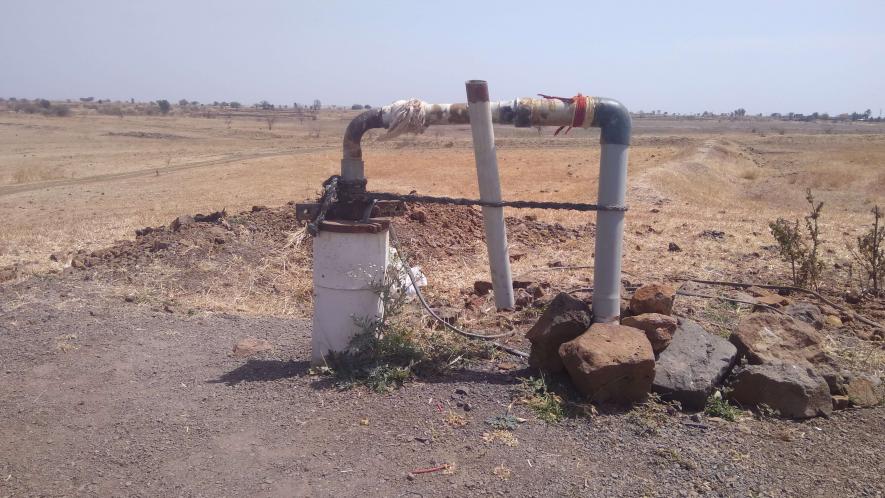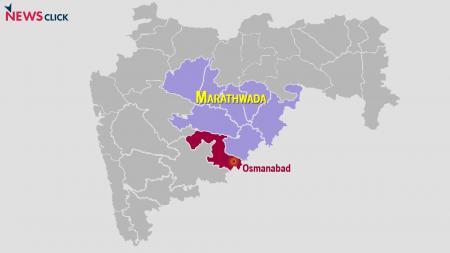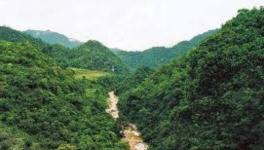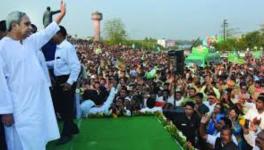#MahaDrought: Bore Wells Get Deeper and Dryer

700 feet bore well of Chinchpur Dhage village of Osmanabad
[Maharashtra is facing one of the most severe droughts since 1972, with the state government declaring drought in 180 tehsils out of 350. Entire Marathwada (spread across Southern and Eastern Maharashtra) region is in dire condition now. This is part 3 of the series of ground reports by Newsclick.]
Bhoom: Sakshi Babu Chavan is studying in standard V. She waits for the tap of the borewell to open, so that she can take four buckets of water home. She comes from Pakhrud village of Bhoom tehsil in Osmanabad. It is one of the worst hit tehsils from the Marathwada region of Maharashtra.

“Our school closes at 5 pm. Then I come here for water. Usually, we all wait till 7 pm. We need to be in line so that we don’t miss our turn to fill the bucket,” says Sakshi.
“I study after 10 in the night. But I can’t study for long. I need to wake up early in the morning every day,” she adds.
Sakshi stands at the borewell which runs on electricity. “Electricity comes at around 7 pm in the evening. So, we get water only after that. Although, enough water is never guaranteed,” says Sakshi’s neighbor, who also stands in the queue, Samabai Magar Bhosale.
Depletion in water table in Marathwada is one of the most crucial issue plaguing Maharashtra now. Recent news reports suggest that water level has gone down to 9 metre in 24 tehsils out of 69 in the region. Bhoom is one of those tehsils where water level has gone down to around 4.09 metre in the last five years. This has resulted in search for ground water at deeper levels through borewells.
Dhananjay Bojane, a 29-year-old farmer from Chinchpur Dhage village of Bhoom tehsil, has two bore wells at his farm. “One is 600 feet deep. But that doesn’t have water. Another one is 587 feet deep. This one is working fine as of now,” he says. The depth of these bore wells shows how situation is worrisome in Marathawada. “There are a few bore wells in our village where even 700 feet digging hasn’t helped draw water,” says sarpanch of the village, Vishal Dhage.
Also read: #MahaDrought: The Empty Market Yards of Osmanabad
Interestingly, 700 feet can translate to the height of a 46-storeyed building of Mumbai, assuming that the height of one floor is 15 ft.
Out of eight districts, seven are facing serious crisis of depletion in ground water table. Highest depletion is in Vashi of Osmanabad district with water level further reduced by 8.3 metre in the last five years. This reduction in the last five years for Beed is around five metre; for Latur, 3.5 metre; for Parbhani, 4.5; meters, for Jalana, 4.3 metre, for Hingoli four metre, and for Aurangabad 4.2 metre.
As people are digging deeper wells in their farms, the bore well business has seen fortunes in the region. “I spent Rs 60,000 for one borewell. If you get good water, then you need Rs 40,000-50,000 more for plastic pipe casing of the bore well,” says Dhananjay Bojane. This is also evident when you travel through Marathwada, as the highest advertisements flashing on the walls around are of the bore wells and water pumps.
Water conservation experts are worried about this depletion. “We need rules and strict implementation of water table maintenance. There is a law for ground water maintenance from 2009. But rules are not yet framed. So, this is happening everywhere,” says irrigation expert Pradeep Purandare.
He adds, “People believe that the ground water in their farms is their private property. But it is not. Well water is different from bore well. So, we need to make people aware of it,” he said.
Read More: #MahaDrought: Without Fodder Camps, Farmers Forced to Sell Cattle at Giveaway Prices
Get the latest reports & analysis with people's perspective on Protests, movements & deep analytical videos, discussions of the current affairs in your Telegram app. Subscribe to NewsClick's Telegram channel & get Real-Time updates on stories, as they get published on our website.























